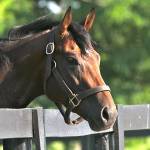Breeding Stallions: Nutrition Matters

Achieving and maintaining a stallion in appropriate body condition tops the list of nutritional concerns for stallion managers. Too often, stallions become ribby because of breeding efforts or anxiety, or obese due to spring grass and inactivity.
Body Condition
Priming a stallion’s weight for breeding season starts well before the first mare of the year requires semen. Like all horses, stallions are individuals and should be fed with their specific metabolism in mind. “Some stallions can maintain weight throughout the year on forage and a ration balancer, even when covering many mares, while others can get so worked up about breeding that they melt away their fat reserves,” explained Kathleen Crandell, Ph.D., a nutritionist for Kentucky Equine Research.
For stallions that maintain weight during breeding season, starting the season with a body condition score (BCS) of 5 or 5.5 is ideal. On the flip side, for stallions that drop weight as the breeding season progresses, beginning the season with a BCS of 6.5-7 may be the only way to keep the stallion in reasonable weight. During the breeding season, weight should be monitored weekly or biweekly and appropriate dietary adjustments made.
Obesity is no ally for a stallion. Repercussions of excessive body weight are numerous: diminished libido, subfertility, increased strain on the joints of the hindquarters, and possible cardiovascular issues. When chronically overconditioned, stallions may not have the stamina to breed a full book of mares. Just as excess weight can make a person more sedentary, so it is with stallions–their minds may say “go,” but their bodies say “no.”
Diet Considerations
“Matching dietary energy intake with energy expenditure is the way to control body condition,” said Crandell. According to Nutrient Requirements of Horses, stallions have greater energy needs than mares and geldings, even when they’re not breeding. “Hormones can influence metabolic rate and cause stallions to have a higher energy requirement at maintenance than other horses.”
How often a stallion is asked to breed affects energy requirements, as does the horse’s focus and disposition. Some stallions take breeding in stride with few behavioral changes, while others get really worked up when mares are nearby, wasting calories calling to mares, stall-walking, or pacing the fenceline. “In general, the energy requirement increases by about 20-25% during the breeding season, equivalent to the difference in an idle lifestyle and light work,” explained Crandell.
Above all, the diet should provide ample amounts of a good-quality forage. Additional caloric needs can then be met through the use of a concentrate. For those easy keepers, the concentrate may be a ration balancer, which will augment the nutrients found in forage. Others need larger amounts of a well-fortified, energy-dense feed to maintain weight. In choosing a feed, adequate but not excessive protein is important, as the requirement for protein increases only slightly with breeding and is usually covered by the increase in feed intake.
“The way energy is delivered to stallions makes a difference and may help diminish or add to anxiety. For nervous, tightly-wound stallions, providing a diet high in digestible fiber and fat instead of high in starch can increase the caloric intake without increased starch, which can make some horses nervous,” Crandell said.
Stallions that lose their appetite with the work of breeding may need a calorie-dense performance feed, which should be high in fat. Many performance feeds are textured and include molasses, which is palatable to finicky eaters. If the horse is not on fresh green grass, supplemental natural vitamin E may be warranted, particularly if feeding a high-fat diet. Choose a natural-source, water-soluble vitamin E, like Nano-E.
Targeted Supplementation
Routine supplementation with high-quality supplements can help stallions in the breeding shed.
One supplement endorsed by several stallion stations is fish oil, due to its favorable omega-3 fatty acid profile, which includes docosahexaenoic acid (DHA) and eicosapentaenoic acid (EPA). Research has made clear the benefits of DHA for stallions. “Though DHA won’t make an infertile stallion fertile, it can help with diminished motility, particularly with cooled semen. In addition to its benefits to semen, it helps with lubrication of joints, so stallions may feel better about mounting and breeding mares,” Crandell said. One effective marine-derived omega-3 supplement on the market is EO-3.
One study suggested that DHA appeared to be better absorbed when the diet contained a source of supplemental fat, so feeding either a high-fat concentrate or adding a little vegetable oil (soybean, canola) to the diet is recommended.
In early breeding season, when pasture might not be available to stallions, vitamin E supplementation should be considered. “Not only will supplementation meet vitamin E requirements for horses consuming hay or other preserved forage, it may have some beneficial effects on fertility,” explained Crandell. Nanodispersion technology confers rapid and superior bioavailability, so look for vitamin E supplements with this feature, such as Nano-E.
Breeding places much strain on joints, especially those in the hind limbs. Joint pain can limit a stallion’s willingness to breed. To help protect joints, high-quality joint supplements, such as Synovate HA and KER-Flex, can be given. In Australia, look for Synovate HA and Glucos-A-Flex.








